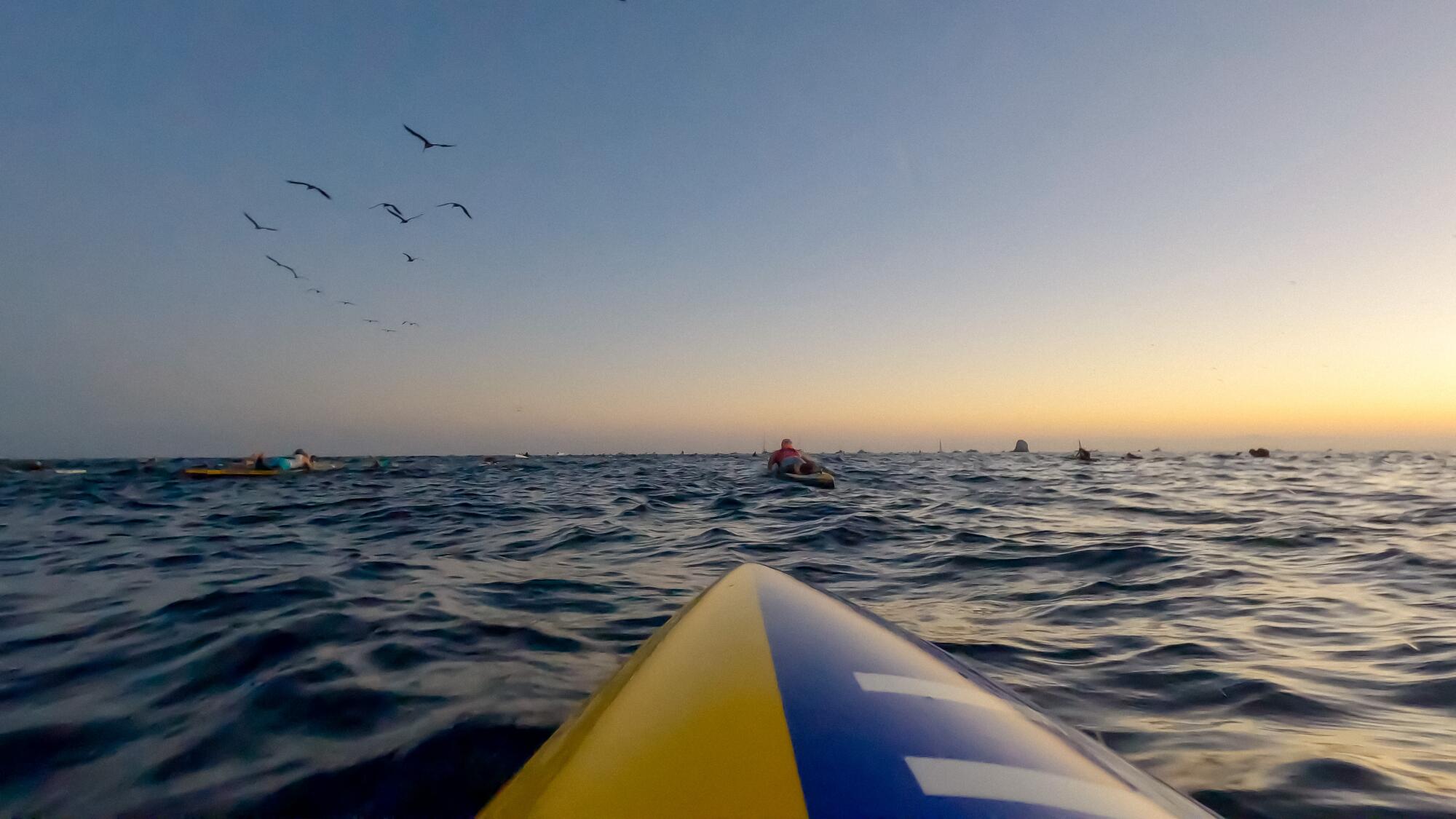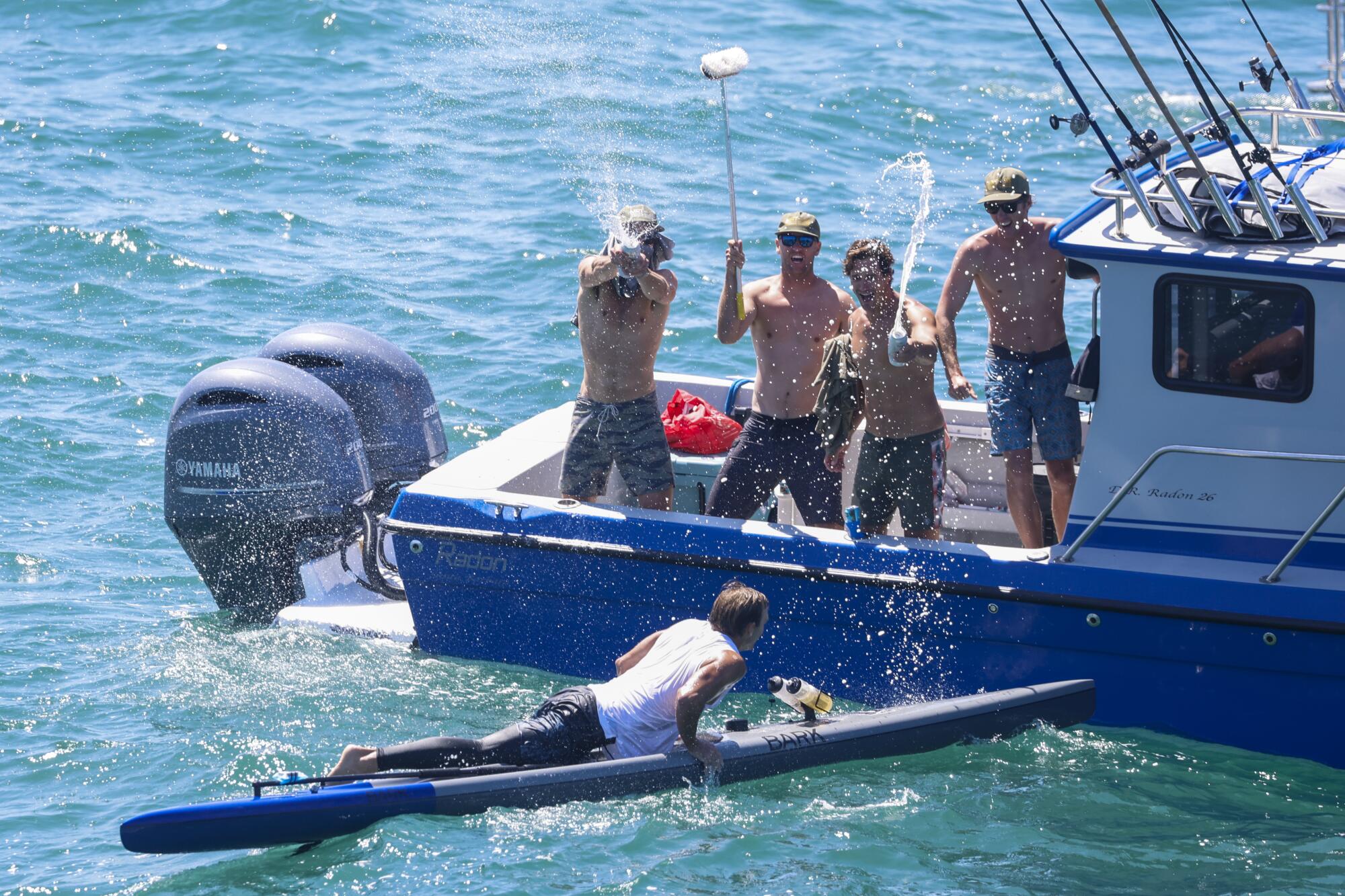[ad_1]
After waking before dawn on Catalina Island beneath a vast bowlful of stars, 100 elite athletes prepared to cross the open ocean to Manhattan Beach using only their arms for power.
The race they were about to start, the 32-mile Catalina Classic Paddleboard Race, is one of the most grueling endurance contests on the planet — an ultra-marathon of the sea — and an annual rite of passage in Southern California surf culture.

Racers prepare for the dawn start of the Catalina Classic.
(Jack Dolan / Los Angeles Times)
Participants are required to lie prone on their bellies on surfboards, their heads cocked upward to see where they’re going, while they claw through wave after endless wave with their bare hands.
For most people, that position, a bit like the sphinx pose in yoga, is hard to hold for more than a minute on dry land. These racers have to hold it, or another position that’s arguably more painful, for six or seven hours in the ocean. And that’s assuming ideal conditions: water flat enough to let their specially designed boards glide a few feet with every stroke.
Which is why, as the racers gathered on the beach nervously stretching and fiddling with GPS trackers before the 6 a.m. start last Sunday, the most experienced among them couldn’t take their eyes off a large American flag.

Racers take to the water at Two Harbors for the start of the 2023 Catalina Classic.
(Black Line (@blacklinelogo)
)
It was dancing all over the place, at times blowing nearly horizontal in the stiff west breeze. If the wind was doing that to a flag in the shelter of the harbor, they shuddered to think what it must be doing to the surface of the open sea.
Gene Rink, a former champion and current race director, took a long look at the flag, let out a slow sigh and told a reporter, “This is going to be 32 miles of torture.”

Course conditions for the annual Catalina Classic vary widely, from calm and smooth to wind-blown and wild. Conditions this year were the most challenging anyone involved could remember.
(Black Line (@blacklinelogo)
)
First held in the 1950s, the Catalina Classic was born from friendly competition among ocean lifeguards in the South Bay. They sprint out into the waves on long, buoyant surfboards to rescue people, so it was only natural to race each other during training to see who was fastest.
Predictably, those short sprints turned into longer contests between obvious landmarks. A two-mile race from the Manhattan Beach Pier to the Hermosa Beach Pier, for example. When that got too easy, they picked more distant points along the coast and kept going, always looking for the next challenge.
Anyone who has sat on a surfboard off the coast of Los Angeles, scanning the western horizon for waves, knows the biggest and most obvious landmark of all is Catalina Island. Twenty-two miles off San Pedro and rising more than 2,000 feet above the ocean, it dominates a surfer’s field of vision: looming, almost taunting.
No matter how insane it seems, this race was inevitable.
While there are still many lifeguards competing, today’s race is open to anyone who submits a “race resume” with suitable times from seven less prestigious, but still brutal, competitions. Most are in California and Hawaii; almost all are less than half the distance of the Catalina Classic.
Venturing so far offshore on a surfboard presents many hazards, but a question racers often hear after they explain to people why they spend all year training is: “What about sharks?”
They’re out there, definitely, but they show little interest in the paddlers. Maybe that’s because humans, in general, are not on their diet. And humans on 12 -to 18-foot surfboards look nothing like their normal prey.
“Sharks never crossed my mind, honestly,” said Tim Gair, an L.A. County lifeguard whose 1999 record time — 5:02:12 — still stands.
“A few years ago there was a pesky mako shark that kept circling in on a few paddlers,” Gair recalled, “but it just lost interest eventually and turned away.”

Robert Parch Jr. carries his paddleboard ashore after placing third in the 2023 Catalina Classic.
(Ringo Chiu / For The Times)
A large adult great white cruised through the pack during a shorter race from Catalina to San Pedro earlier this summer, said Casey Annis, 57, from Cypress. It startled people, but didn’t harm anyone.
If he’s going to be eaten by a shark during the classic, Annis joked, he hopes it happens before he suffers too much. “Better in the first two miles than the last two,” he said.
Massive cargo ships are a more serious concern. The route from Catalina to Manhattan Beach cuts straight across the approach to the Port of Los Angeles, one of the busiest shipping lanes in the world. It takes those ships, some of which are more than 1,000 feet long and as tall as an 11-story building, miles to turn and forever to stop.
That’s a problem because the most hard-core racers are tempted to speed up and take their chances. They don’t want to wait for a ship to pass. They want to sprint across its path and cruise in smug solitude while their competitors have to wait behind.
“We’ve had a couple of close calls over the years,” Gair said, “to the point where the ships have called the race boats and said, ‘Hey, I can’t stop!’”
But ask any of the paddlers what they fear most and they’ll tell you it’s fatigue — the race is just so miserably long.
To relieve the physical strain, racers can get up off their bellies and onto their knees. Then they reach down and paddle with both arms at the same time. That generates more power, but it’s even harder to sustain for long stretches. Some say they switch back and forth between the positions just so some other part of their body hurts for a while.
There’s also the mental battle, forcing yourself through an event that’s about as much fun as “running up the down escalator for seven hours,” Annis said.
His trick is compartmentalization.

Shane Gallas, front, and Lockwood Holmes compete in the grueling 2023 Catalina Classic.
(Ringo Chiu / For The Times)
“If you’re out there and you’re thinking, ‘Oh, God, I have five more hours of this,’ that’s when you’ll implode,” Annis said. Instead, he tells himself, “just last one more minute” or “one more song.”
Essentially, he gaslights himself to the finish line.
Another problem — one rarely faced by athletes who compete on land, or swimmers who stick to pools — is the extreme variability in conditions. One year, the course might be calm and smooth, allowing for record times. The next it can be wind-blown and wild, forcing racers to paddle up and down so many swells, and blowing them so far off course, it’s like adding 10 miles to the distance.
This year’s race was the worst anyone can remember.

Jake Miller is congratulated by his team after placing second in the 2023 Catalina Classic.
(Ringo Chiu / For The Times)
There’s not much lodging on the north end of Catalina where the race starts, so most of the competitors sleep on their escort boats — everyone is required to have one for safety — or in campgrounds onshore. The wind that blew all night before the race, rocking smaller vessels on their moorings and rattling the nylon walls of tents, robbed many of any chance at meaningful rest.
So they already knew they were in trouble when dawn broke and they waded knee-deep into the water, perched over their boards waiting for the starter’s horn. That flapping American flag erased any doubt about what lay ahead.
Within minutes, as soon as the paddlers left the sanctuary of the little cove, radios on the safety boats crackled with reports from anxious boat captains who had temporarily lost sight of their racers in the 6-foot swell. Less than an hour in, the first racer waved his boat over and struggled aboard, defeated by the appalling conditions. Six others would soon follow.
Boat crews suffered, too.
Rink and Gair were on one of the official race vessels, weaving slowly through the pack to help track down stray paddlers and keep tabs on who was still in the competition. As Gair steered the wildly pitching boat, Rink inched out to the bow, clinging to handrails and bracing himself against the cabin every step of the way.
At one point, Rink was shouting encouragement to some paddlers from his perch on the front of the boat while the race photographer was hanging off the back, puking. He threw up at least seven times during the race, he said, and he didn’t paddle a single stroke.
At another point, as the boat paralleled the two leaders, who were well ahead of the pack, Gair noted the time (late) and how much distance they’d managed to cover (surprisingly little). Without a hint of the schadenfreude he could be forgiven for feeling, he acknowledged that his record would almost certainly survive its 24th challenge and that an even 25 would be nice.

Scott Clausen, right, is congratulated by Jake Miller after winning the race.
(Ringo Chiu / For The Times)
When the winner, Scott Clausen from Seal Beach, finally crossed the finish line in 5:46:27 — or 44 minutes slower than Gair’s record — Clausen looked shattered. But at least he could still stand.
Many of the mid-pack finishers, and those at the tail end, wobbled ashore, red-eyed and struggling to speak. Requests to “come up and say a few words” from a pair of commentators calling the race over loudspeakers on the beach were routinely ignored — at least until the racers got their bearings.
“That was miserable, that was absolutely miserable,” said Scott Rusher, 55, from Manhattan Beach, who has done the race 19 times. He finished in 7:46:07, about 90 minutes longer than he expected.
“Far and away, that was the worst,” Rusher said, “From the beginning, to the middle, to the end.”
The shifting wind and wild swells slammed him from every direction. “It was like a washing machine,” Rusher said. “There was no rhythm, no way to get in a groove.”
It took Annis more than 30 minutes longer than Rusher. He said he’d spent so much of that time being battered by swell from the left, he had to use his right arm to compensate, pushing to the side to keep his board on course instead of using it to pull himself forward.
“I can’t raise my right arm now,” he texted a reporter after the race.

Shane Gallas, left, and Lockwood Holmes hug in exhaustion after crossing the finish line in Manhattan Beach.
(Ringo Chiu / For The Times)
And all for what, exactly?
“There’s no prize money, no accolades, no [media] coverage anywhere of any type,” Annis said.
All you get is a group photo with the other finishers and what he called a “toothpick,” a miniature wooden surfboard that says, “Catalina Classic Finisher” and the year.
But there is real camaraderie. Annis trains with partners all year, and some have become close friends, like a second family. When you take a group of like-minded people and make them suffer together, it creates a bond like nothing else.
So, as crazy as it sounds, Annis said, “if my house ever catches fire, the only things I’m racing in to save are those stupid toothpicks.”
[ad_2]
Source link